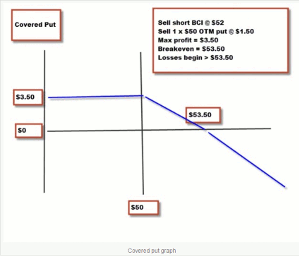Alan Ellman of TheBlueCollarInvestor.com maps out the differences between covered puts and covered calls for those new to options trading or for those who desire a refresher.
Recently, I have received inquiries on related strategies that have led to some confusion specifically about covered puts so I decided to devote this article to that topic.
Defining the two strategies
Covered calls = Buy stock + sell call option = long stock + short option.
Covered puts = Sell stock short (borrow shares from broker) + sell put option = short stock + short put option.
Note: Selling cash-secured puts is a third strategy that involves only a short put option position secured by enough cash to purchase the shares if the option is exercised.
Outlook for covered puts
A writer of covered puts has a slightly more bearish outlook than does the covered call writer as you will see as we calculate returns later in this article.
Hypothetical example
Sell short 100 shares of BCI @ $52 = $5200 cash generated into your brokerage account.
Sell 1 x $50 out-of-the-money put for $1.50 = $150 cash generated into account.
We now have two obligations: One to buy the shares @ $50 if the option holder chooses to exercise and the other to replace the 100 borrowed shares.
Breakeven
$53.50—any move above $53.50 will result in a loss. At this price we will lose $150 replacing the shorted stock (sold at $52 and bought @ $53.50) which is compensated for by the $150 put premium sale.
Maximum profit
$2 on the stock side ($52 – $50) for closing prices under $50 + $1.50 from the put sale = $3.50/share = $350/contract.
No matter how low the share price moves, we purchase the shares @ $50 due to our put obligation and this is why covered puts is a bearish strategy as we max our trade as share price declines and lose money if share price accelerates past the breakeven ($53.50 in this case).
Maximum loss
Technically, unlimited as share price rises above $53.50, but $150 less than if the put was not sold and only the stock shorted. This also assumes no position management, an unfair assumption for educated investors.
Covered put graph
Type of brokerage account required and level of trading approval needed
Since the strategy involves shorting a stock, a margin account (not a cash account) is required with a high level of trading approval, much higher than that required for covered call writing.
Margin and interest
This will vary from broker-to-broker but a typical margin requirement of the short stock sale is 50% ($2600 in this case) and none on the options side. Since we are borrowing the stock from our broker, we will be required to pay interest on that loan and this should be calculated into our results.
Summary
Most strategies—if implemented and managed properly—can be profitable. For most retail investors, covered puts are not appropriate and should be considered only by experienced, sophisticated investors. Covered puts and selling cash-secured puts are two completely different strategies.
By Alan Ellman of TheBlueCollarInvestor.com






















